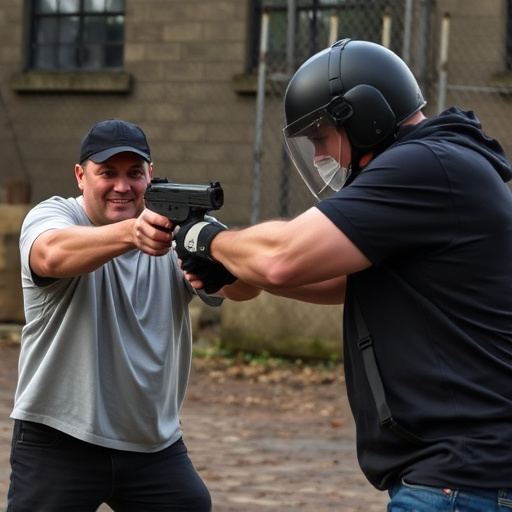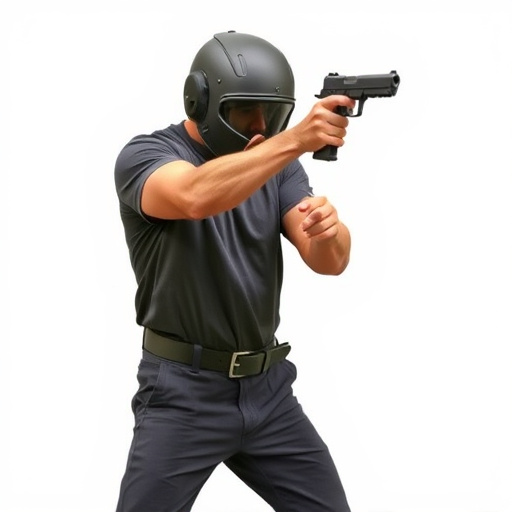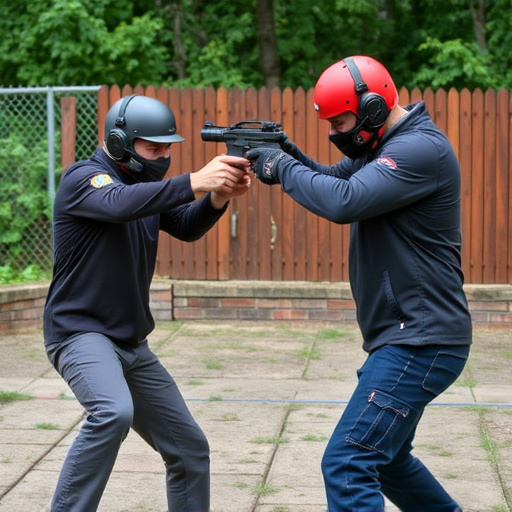In today's digital age, concealed stun gun detection technology is rapidly evolving due to growing concerns about women's personal safety. The market offers advanced tools like metal detectors and thermal imaging devices with varying effectiveness influenced by battery life, detection range, and false positive rates. When selecting a stun gun, consider not just the device but its supporting technology. Modern stun guns prioritize compactness, lightweight design, high voltage, and extended discharge time for maximum effectiveness, often featuring LED lights and alarms. They operate silently to avoid attracting attention during critical situations, debunking the myth that metal detectors are effective against them. Key innovations include advanced electromagnetic field sensing technology and AI/machine learning integration for reliable identification. Understanding local laws regarding stun gun carriage is crucial, as discreteness is vital for women seeking a personal safety tool that can be easily carried without drawing attention.
“In an era where personal safety is a paramount concern, especially for women, concealed stun gun detection has emerged as a critical aspect of self-defense. This article delves into the intricate world of stun gun technology, focusing on why it’s a key area for women’s safety. We explore common misconceptions, dissect advanced detection systems, analyze legal considerations, and guide readers through choosing the best self-defense stun gun to overcome detection challenges. Understanding these factors is vital in empowering individuals, particularly women, to protect themselves effectively.”
- Understanding Concealed Stun Gun Detection: The Current Landscape
- Why Women's Self-Defense is a Focus Area for Stun Gun Technology
- Common Concerns and Myths About Detecting Stun Guns
- Advanced Technologies in Stun Gun Detection Systems
- Legal Implications: Right to Carry Laws and Their Impact on Detection
- Choosing the Best Self-Defense Stun Gun: Features to Overcome Detection Challenges
Understanding Concealed Stun Gun Detection: The Current Landscape

In today’s digital era, concealed stun gun detection technology is evolving rapidly, driven by concerns over personal safety, especially for women seeking effective self-defense solutions. The current landscape presents a mix of advanced and emerging tools designed to identify stun guns hidden on individuals. From metal detectors to thermal imaging devices, various methods are in use or under development. However, the effectiveness of these tools varies significantly based on factors like battery life, detection range, and false positive rates.
When considering the best self-defense stun gun for women, it’s crucial to look beyond the device itself and examine the supporting technology. Advanced detection systems that integrate seamlessly with stun guns offer promise in enhancing personal security. However, users must be informed about limitations and potential challenges, such as interference from everyday objects or weather conditions, to make informed decisions.
Why Women's Self-Defense is a Focus Area for Stun Gun Technology

Women’s self-defense has become a significant focus area for stun gun technology, as women are often considered more vulnerable to physical attacks and assault. The need for an effective yet non-lethal self-defense tool is crucial, especially for those who feel unsafe in public spaces or within their own homes. Stun guns, also known as electronic control devices (ECDs), offer a powerful option that can incapacitate an attacker without causing permanent harm.
When it comes to choosing the best self-defense stun gun for women, several factors come into play. Compact size and weight are essential for ease of carry, while high voltage and a long discharge time ensure maximum effectiveness during emergencies. Many modern stun guns also incorporate features like LED lights, alarm systems, and durable construction to enhance their usability and reliability in diverse situations.
Common Concerns and Myths About Detecting Stun Guns

Many people, especially women looking into self-defense options, have concerns and misconceptions about stun gun detection. One common myth is that all stun guns emit a distinct sound or signal that can easily be detected by security systems. In reality, modern stun devices are designed to minimize these signatures, making them far less conspicuous than traditional firearms. Advanced models feature silent operation, ensuring they don’t trigger alarms or attract attention during critical situations.
Another worry is the reliability of detection methods. Some argue that metal detectors commonly used in public spaces aren’t effective against stun guns due to their unique design and materials. However, dedicated stun gun detectors exist, specifically designed to identify these devices through advanced electromagnetic field sensing, offering a more reliable solution for concerned individuals seeking the best self-defense stun gun for women.
Advanced Technologies in Stun Gun Detection Systems

The evolution of stun gun detection technology has led to advanced systems capable of identifying concealed weapons with impressive accuracy. One of the key innovations is the use of advanced metal detectors, which employ sophisticated sensor arrays and signal processing algorithms to detect even small stun guns. These sensors can pick up on subtle disturbances in electromagnetic fields, allowing for the early detection of potentially dangerous devices.
Furthermore, some cutting-edge systems integrate artificial intelligence (AI) and machine learning capabilities, enabling them to learn and adapt to various environments and personal items that might interfere with detection. This ensures that the best self-defense stun gun for women, or any individual, is quickly and reliably identified, enhancing safety measures significantly.
Legal Implications: Right to Carry Laws and Their Impact on Detection

The legal landscape surrounding concealed weapon carry, including stun guns, varies significantly across jurisdictions. In many regions, individuals have the right to carry self-defense tools for personal protection, a concept often encapsulated in “Right to Carry” laws. These laws not only define who can possess a stun gun but also set parameters for its detection and use. For example, some states mandate specific registration or licensing procedures for stun gun owners, while others may have exceptions for self-defense purposes, making it crucial for citizens to understand their local regulations.
When it comes to best self-defense stun guns for women (or anyone seeking personal protection), the impact of Right to Carry laws on detection is profound. These laws often require law enforcement and security personnel to be equipped with the knowledge and tools to identify concealed stun guns, ensuring they can respond appropriately during encounters. However, the same laws also raise concerns about privacy and the potential for false positives or negatives in stun gun detection, especially in crowded areas where many individuals might lawfully carry personal defense devices.
Choosing the Best Self-Defense Stun Gun: Features to Overcome Detection Challenges

When selecting a self-defense stun gun, focusing on features that enhance discreetness is crucial, especially for women who may want to carry it as a personal safety tool without drawing unnecessary attention. Look for compact designs with ergonomic grips allowing for easy concealment in purses or pockets. A low-profile stun gun is less likely to trigger metal detectors and can be quickly deployed when needed.
Additionally, consider models with adjustable settings. While maximum power might be appealing, a lower setting offers more control during close encounters, minimizing the risk of accidental discharge and attracting unwanted attention. The best self-defense stun gun for women should balance effectiveness, ease of use, and discreetness to ensure personal safety without compromising privacy or convenience.
In light of the growing importance of self-defense among women, understanding concealed stun gun detection and choosing the right device is paramount. The current landscape highlights various advanced technologies aimed at enhancing safety without infringing on privacy rights. By navigating common concerns and legal implications, such as right-to-carry laws, individuals can select a best self-defense stun gun tailored to their needs. Features like compact design, high voltage output, and discreet activation mechanisms play crucial roles in overcoming detection challenges, ensuring women have a reliable option for personal safety without drawing unnecessary attention.
